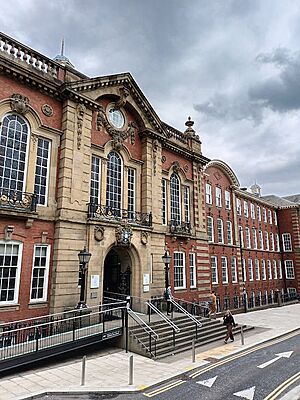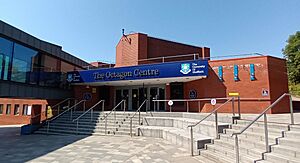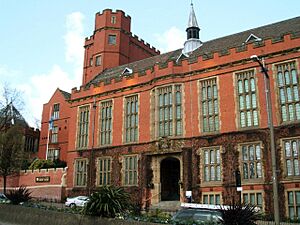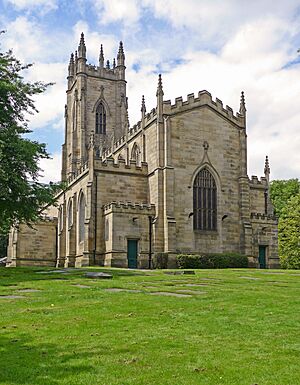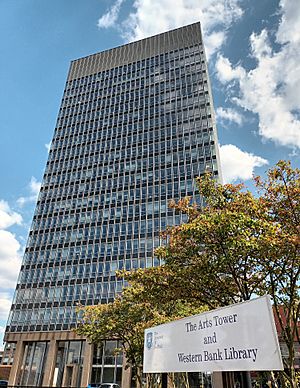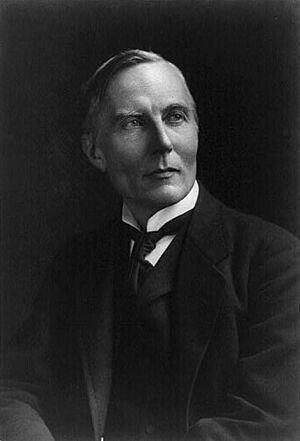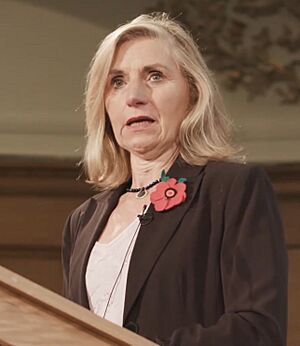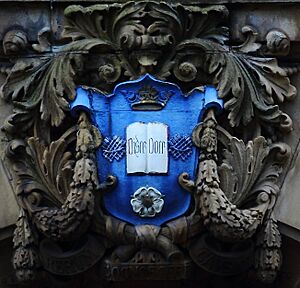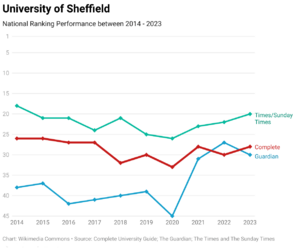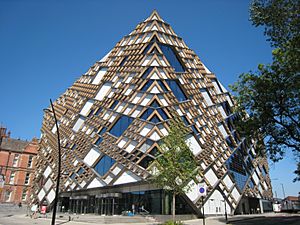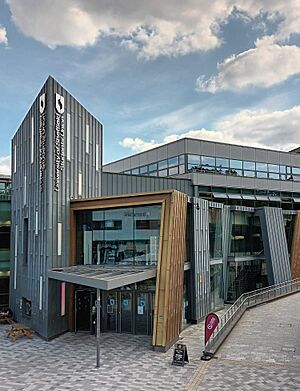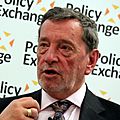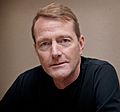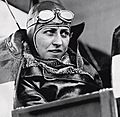University of Sheffield facts for kids
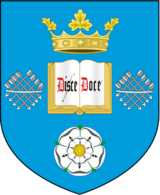
Coat of arms
|
||||||||||||||
| Motto | Latin: Rerum cognoscere causas | |||||||||||||
|---|---|---|---|---|---|---|---|---|---|---|---|---|---|---|
|
Motto in English
|
To discover the causes of things | |||||||||||||
| Type | Public research university | |||||||||||||
| Established | 1905 – University of Sheffield Predecessor institutions: 1828 – Sheffield Medical School 1879 – Firth College 1884 – Sheffield Technical School 1897 – University College of Sheffield |
|||||||||||||
| Endowment | £55.2 million (2024) | |||||||||||||
| Budget | £887.9 million (2023/24) | |||||||||||||
| Chancellor | Lady Justice Rafferty | |||||||||||||
| Vice-Chancellor | Koen Lamberts | |||||||||||||
|
Academic staff
|
3,795 (2023/24) | |||||||||||||
|
Administrative staff
|
4,665 (2023/24) | |||||||||||||
| Students | (2015/16) 29,225 FTE (2015/16) |
|||||||||||||
| Undergraduates | (2015/16) | |||||||||||||
| Postgraduates | (2015/16) | |||||||||||||
| Location |
,
,
England
|
|||||||||||||
| Campus | Urban | |||||||||||||
| Colours | Black & gold
|
|||||||||||||
| Affiliations |
|
|||||||||||||
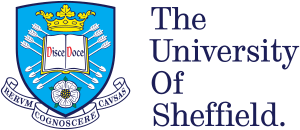 |
||||||||||||||
The University of Sheffield is a large public university in Sheffield, England. It's also known as Sheffield University or TUOS. The university started from three older schools: the Sheffield Medical School (1828), Firth College (1879), and Sheffield Technical School (1884). These schools joined together in 1897 to form the University College of Sheffield. In 1905, King Edward VII officially made it the University of Sheffield.
Today, the university has 50 different departments. These are grouped into five main areas called faculties, plus an international faculty. In 2023–24, the university's income was about £887.9 million. A big part of this, £185.8 million, came from research projects. Sheffield is known as one of the best engineering universities in Europe. It has had the highest income for engineering research in the UK for two years in a row.
The University of Sheffield is one of the original "red brick universities." These are older universities built in big industrial cities in England. It's also a founding member of the Russell Group, which is a group of leading research universities in the UK. The university is also part of other important groups like the Worldwide Universities Network and the N8 Group.
Many famous people have connections to Sheffield. Six Nobel Prize winners have studied or worked there. They helped discover things like penicillin, how our bodies use energy (the citric acid cycle), and how to study super-fast chemical reactions. Other famous alumni include leaders of countries, judges, writers, astronauts, and Olympic medal winners.
Contents
History of Sheffield University
How the University Started
The University of Sheffield was created by joining three local schools. These were the Sheffield School of Medicine, Firth College, and the Sheffield Technical School. The oldest of these, the Sheffield School of Medicine, began in 1828. It was the first place in Sheffield to offer higher education.
In the 1870s, people wanted more education in cities that didn't have universities. Sheffield was growing fast because of its steel industry. So, in 1871, lecturers from Oxford and Cambridge universities came to Sheffield to give talks. A steel maker named Mark Firth and a clergyman named Samuel Earnshaw started popular classes. Mark Firth then gave £20,000 to build a new place for these classes. This became Firth College in 1879. It taught arts and science subjects. Firth College also helped the medical school, which was struggling, and took over teaching basic subjects to medical students.
Firth College also helped start the Sheffield Technical School in 1884. This school taught applied science, like engineering. People in Sheffield wanted more technical training, especially for making steel. Many steel companies helped fund the Technical School. The research done there helped them create new products. The Technical School moved to St George's Square (now Mappin Street) in 1886.
Becoming a University
At that time, Sheffield was the only big city in England without a university. William Mitchinson Hicks, who led Firth College, wanted to create a university in the city. First, he worked to combine the three schools into one "university college." He also added new departments and buildings. In 1897, Firth College, the Medical School, and the Technical School joined to form the University College of Sheffield. Hicks became its first leader.
In 1903, they decided to ask for a special permission from the King to become a full university. They bought land for new buildings, including the main building known today as Firth Court. In 1904, ordinary people in Sheffield, like steelworkers and miners, donated over £50,000 to help start the university. This showed how much the community wanted a university.
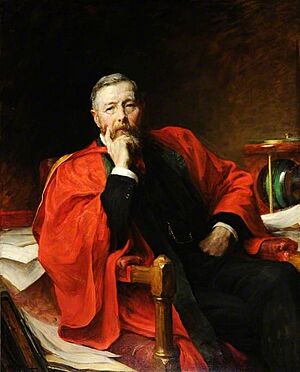
The University College of Sheffield officially became the University of Sheffield on May 31, 1905. On July 12, 1905, King Edward VII and Queen Alexandra opened Firth Court. The university is one of the six "red brick universities" that were founded in England's industrial cities before World War One.
The 20th Century at Sheffield
When the university first opened in 1905, it had 363 students. During the First World War, some courses changed to teach how to make weapons and medical tools. The university grew slowly until the 1950s and 1960s, when it expanded quickly. Many new buildings were built, like the Main Library and the Arts Tower. The number of students grew to almost 26,000.
In the 1980s, new buildings like the Octagon Centre opened. The university also started working with other universities to help international students. In the 1990s, more new buildings opened, and the university took over a nursing and midwifery college. This made the medical faculty much larger.
Important scientific discoveries happened at Sheffield. Hans Adolf Krebs discovered the citric acid cycle in 1937, which won him a Nobel Prize in 1953. This cycle explains how our bodies create energy. George Porter also did Nobel Prize-winning work at Sheffield on super-fast chemical reactions.
Sheffield in the 21st Century
In the 2000s, the university opened many new buildings, including the Jessop Building and the Information Commons. Older buildings like the Arts Tower were also updated. A new campus, North Campus, was opened. In 2015, a large new building called the Diamond was opened.
Since 2016, the university has been working with the Sheffield City Council to improve the areas around the campus. This includes making better paths for walking and cycling. Recent projects in the 2020s include new buildings for the Information School and Social Sciences.
University Campus and Locations
The University of Sheffield doesn't have one big campus like some universities. Instead, its many buildings are spread out but still close to each other. A main road, Upper Hanover Street, divides the university into two main areas: Western Bank and St George's campus.
The university has buildings from different time periods, from old Victorian styles to very modern designs. Many of its buildings are "listed," meaning they are important historical buildings. The Arts Tower and Western Bank Library are especially important, listed as Grade II*.
Main (Western Bank) Campus
This is the main part of the university, about a mile west of Sheffield city centre. It has many university buildings close together. Key buildings here include Firth Court, Alfred Denny Building, Western Bank Library, and the Arts Tower. The Students' Union and the Octagon Centre are also in this area. A walkway under the main road connects buildings on both sides. The Information Commons, a library and computer centre, opened here in 2007 and is open 24/7.
St George's Campus
This campus is east of the main campus and is named after St George's Church, which is now a lecture theatre. This area is where the Sheffield Technical School used to be. It's often called the Engineering campus because it's home to the Faculty of Engineering, located in the Mappin Building. The Department of Journalism Studies and Computer Science are also here.
The university has also turned the old Jessop Hospital for Women into the new home for the Department of Music. The Diamond building, which opened in 2015, is also on this campus. It's a modern building with lecture theatres and labs for engineering students.
The Sir Frederick Mappin Building is a historic building that houses much of the Faculty of Engineering. In 2020, it was updated with a new glass-roofed area called the Engineering Heartspace.
Other University Locations
Further west, you'll find Weston Park, the Weston Park Museum, and the university's sports facilities. The Faculty of Medicine, Dentistry and Health is located around the Royal Hallamshire Hospital. The Sheffield Institute for Translational Neuroscience (SITraN), which researches brain diseases, is also in this area.
North Campus, located north of St George's campus, has research institutes like the Kroto Research Institute. The university also has Advanced Manufacturing Research Centres (AMRCs) in Rotherham and Lancashire, where they work with companies on new manufacturing ideas.
How the University is Organized
University Faculties and Schools
In 1905, Sheffield University had four main faculties: Arts, Pure Science, Medicine, and Applied Science. Today, the university has five main faculties and one international faculty.
- Faculty of Arts and Humanities
- School of English
- School of History, Philosophy and Digital Humanities
- School of Languages, Arts and Societies
- School of Law
- Faculty of Engineering
- School of Chemical, Materials and Biological Engineering
- School of Computer Science
- School of Electrical and Electronic Engineering
- School of Mechanical, Aerospace and Civil Engineering
- Faculty of Health
- School of Allied Health, Nursing and Midwifery
- School of Clinical Dentistry
- School of Medicine and Population Health (including the Medical School)
- Faculty of Science
- School of Biosciences
- School of Mathematical and Physical Sciences
- School of Psychology
- Faculty of Social Sciences
- School of Architecture and Landscape
- School of Economics
- School of Education
- School of Information, Journalism and Communication
- Management School
- School of Sociological Studies, Politics and International Relations
Faculty of Arts and Humanities
This faculty includes schools like English, History, Philosophy, and Law. It also has research centers. One interesting center used to study Freemasonry, but it closed in 2010. In 2021, there was a discussion about the future of the archaeology department, which caused a lot of international attention.
Faculty of Engineering
This faculty grew from the Sheffield Technical School, which started in the 1880s. During World War One, it trained soldiers and made war supplies. Today, the Faculty of Engineering has over 6,700 students and 1,000 staff. Most of its research is considered "world-leading" or "internationally excellent."
Faculty of Health
This faculty has three schools: Applied Health, Nursing and Midwifery, Clinical Dentistry, and Medicine and Population Health. The Medical School is the oldest part of the university. It's located next to the Royal Hallamshire Hospital and works with other hospitals in Sheffield. It's one of the few places in the UK that can award medical degrees.
Faculty of Science
The Faculty of Science includes departments like Animal and Plant Sciences, Chemistry, and Physics and Astronomy. All six of the university's Nobel Laureates have been connected to this faculty. The Department of Animal and Plant Sciences is one of the biggest in the UK for studying whole organisms.
Faculty of Social Sciences
The Sheffield School of Architecture is often ranked among the top 10 in the UK. It's one of the oldest architecture schools in the country, starting in 1908. It's located on the top floors of the Arts Tower.
The Management School is a business school that has received three important accreditations (AMBA, AACSB, and EQUIS). It moved into new facilities in 2013.
The Information School (iSchool) studies how information works. It's ranked very highly, even second in the world, for Library and Information Studies.
University Governance
The university is run by several groups. The Council handles the big picture, like planning and money. The Senate manages the academic side, like teaching and research. The Vice-Chancellor is the main leader of the university. The current Vice-Chancellor is Koen Lamberts.
Vice-Chancellors of Sheffield University
- 1905: William Mitchinson Hicks
- 1905: Charles Eliot
- 1912: Herbert Fisher
- 1917: William Ripper (acting)
- 1919: William Henry Hadow
- 1930: Sir Arthur Pickard-Cambridge
- 1938: Irvine Masson
- 1953: John Macnaghten Whittaker
- 1965: Arthur Roy Clapham (acting)
- 1966: Hugh Robson
- 1974: Geoffrey Sims
- 1991: Gareth Roberts
- 2001: Bob Boucher
- 2007: Sir Keith Burnett
- 2018: Koen Lamberts
Chancellors of Sheffield University
- 1905: Henry Fitzalan-Howard, 15th Duke of Norfolk
- 1917: Robert Crewe-Milnes, 1st Marquess of Crewe
- 1944: Henry Lascelles, 6th Earl of Harewood
- 1947: Edward Wood, 1st Earl of Halifax
- 1959: Rab Butler, Baron Butler
- 1979: Frederick Dainton, Baron Dainton
- 1999: Sir Peter Middleton
- 2015: Dame Anne Rafferty
- 2025 (incoming): Andy Haldane FRS
University Coat of Arms
The university's coat of arms was given to it in 1905. It has a blue shield with an open book that says Disce Doce (Learn and Teach). It also has eight silver arrows, a golden crown, and the White Rose of York. Below it is the motto Rerum cognoscere causas (To Discover the Causes of Things). This motto was also used by Firth College.
Academics at Sheffield
University Reputation and Rankings
| National rankings | |
|---|---|
| Complete (2021) | 16 |
| Guardian (2021) | 20 |
| Times / Sunday Times (2021) | 14 |
| Global rankings | |
| ARWU (2020) | 151–200 |
| QS (2021) |
92 |
| THE (2021) | 98= |
| British Government assessment | |
| Teaching Excellence Framework | Silver |
The University of Sheffield is known as one of the top universities in the UK. It's part of the Russell Group, a group of leading research universities. In 2025, it was ranked 98th in the world by Times Higher Education.
Sheffield has won the 'University of the Year' award from Times Higher Education in 2011. It has also won the Queen's Anniversary Prize five times for its excellent work. In 2024, it was voted University of the Year and Best Students' Union at the Whatuni Student Choice Awards.
In 2021, Sheffield was ranked 11th in the UK for its research power. This means a lot of its research is considered "world-leading" or "internationally excellent." For example, its Physics and Astronomy research was 100% world-leading.
The university is also recognized globally for specific subjects. In 2023, it was ranked first in the world for Library and Information Management by QS. It also ranked highly for Architecture and Archaeology.
University Admissions
|
| Domicile and Ethnicity | Total | ||
|---|---|---|---|
| British White | 50% |
|
|
| British Ethnic Minorities | 16% |
|
|
| International EU | 2% |
|
|
| International Non-EU | 33% |
|
|
| Undergraduate Widening Participation Indicators | |||
| Female | 51% |
|
|
| Independent School | 10% |
|
|
| Low Participation Areas | 11% |
|
|
In the 2018–19 school year, the University of Sheffield had over 30,000 students. This included about 19,610 undergraduate students and 10,585 postgraduate students. The university accepts a high percentage of its applicants, which is good for students applying.
Many international students come to Sheffield. In 2016–17, about 24% of students were from outside the UK or EU. Most of these international students, 57.8%, were from China.
University Libraries
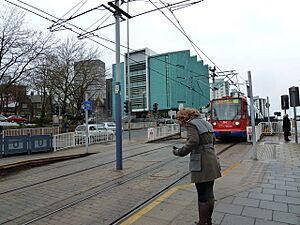
The University of Sheffield has four libraries with over 1.5 million printed books. The main libraries are Western Bank Library, the Information Commons, and The Diamond.
Western Bank Library was the main library until 2007. It has 730 study spaces and many books. The Information Commons (IC) is a special learning center that combines library and IT services. It was the first of its kind in the UK and is open 24/7. It has about 1,300 study spaces.
The Health Sciences Library has two locations at the Royal Hallamshire Hospital and the Northern General Hospital. These libraries have books for medicine, dentistry, and nursing. The Diamond, which opened in 2018, also offers 24-hour library services and over 1,000 study spaces.
University Museums and Collections
The Alfred Denny Museum is a zoology museum run by the university. It started in 1905 and has many animal specimens. It even has two letters written by Charles Darwin. The museum is usually open to the public on the first Saturday of each month.
The Turner Museum of Glass has a collection of glass from the 19th and 20th centuries. It was founded by Professor W. E. S. Turner in 1943. One unique item is a wedding dress made of glass fiber!
The National Fairground and Circus Archive (NFCA) collects items related to fairs, circuses, and other entertainment. It has over 150,000 photographs and many books and journals.
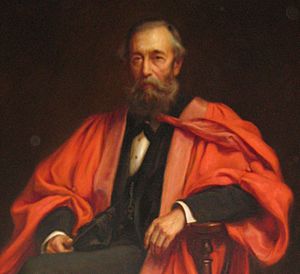
Student Life at Sheffield
Students' Union
The University of Sheffield Students' Union was founded in 1906. It has almost 300 student clubs and nearly 50 sports teams. It has been voted the best Students' Union in the UK for ten years in a row!
The Union building has places for clubs to meet, coffee shops, restaurants, and a student-run cinema. It also has two bars and a club venue. Students run their own radio station (Forge Radio), TV station (Forge TV), and newspaper (Forge Press). The Students' Union building was updated in 2010 and again in 2012–13.
Student Accommodation
The university has student housing in two main areas: Ranmoor/Endcliffe and City. Ranmoor/Endcliffe is in the western part of Sheffield. The Endcliffe Village opened in 2008, and the Ranmoor Village opened in 2009. City accommodation is closer to the main campus.
Sheffield Varsity Sports
The Sheffield Varsity is an annual sports competition between the University of Sheffield and Sheffield Hallam University. It started in 1996. Over 1,000 students from both universities compete in more than 30 sports. The University of Sheffield's sports colors are black and gold. Sheffield has won the Varsity competition for seven years in a row, from 2013 to 2019.
People Connected to the University
Famous Alumni of Sheffield University
Many famous people have studied at Sheffield. These include politicians like David Blunkett (a former Home Secretary) and Nicholas Liverpool (a former President of Dominica). Judges and lawyers, including several from the Court of Appeal, have also studied here.
Writers like two-time Booker Prize winner Hilary Mantel and Lee Child are alumni. Actors like Eddie Izzard also attended. Pioneers like Helen Sharman, the first British astronaut, and Amy Johnson, the first woman to fly solo from London to Australia, are also Sheffield alumni.
In sports, Olympic gold medalists Jessica Ennis-Hill and Hollie Webb studied at Sheffield.
Nobel Prize Winners from Sheffield University
Six Nobel Prize winners have been connected to the University of Sheffield, either as students or staff.
- 1945 Nobel Prize in Physiology or Medicine: Howard Florey, for his work on penicillin.
- 1953 Nobel Prize in Physiology or Medicine: Hans Adolf Krebs, for discovering the citric acid cycle, which explains how cells get energy.
- 1967 Nobel Prize in Chemistry: George Porter, for his work on very fast chemical reactions.
- 1993 Nobel Prize in Physiology or Medicine: Richard J. Roberts, for discovering that genes have "introns" (parts that are cut out).
- 1996 Nobel Prize in Chemistry: Sir Harry Kroto, for discovering "fullerenes," a new form of carbon.
- 2016 Nobel Prize in Chemistry: Sir James Fraser Stoddart, for creating tiny "molecular machines."
Images for kids
-
One of the university's Advanced Manufacturing Research Centres in Rotherham
See also
 In Spanish: Universidad de Sheffield para niños
In Spanish: Universidad de Sheffield para niños



